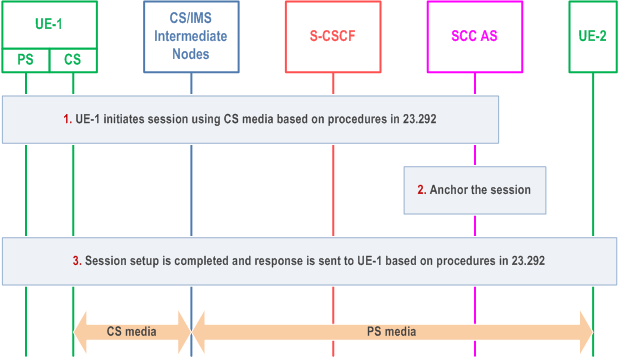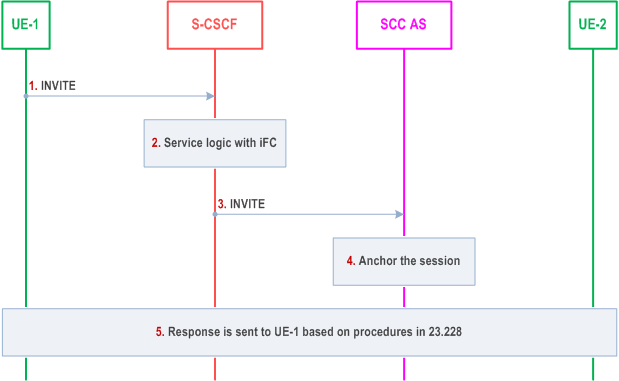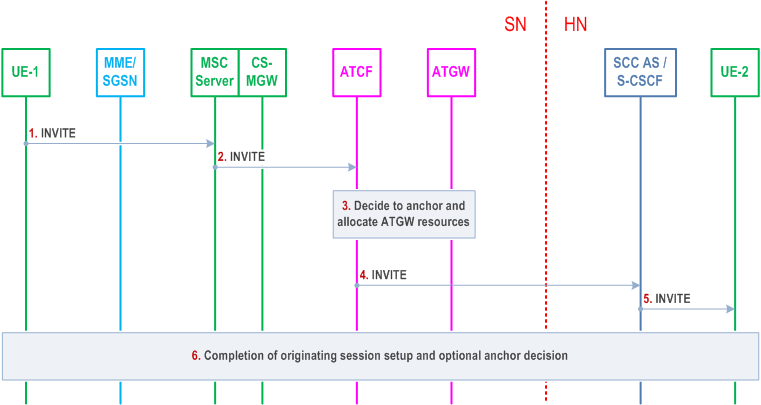Content for TS 23.237 Word version: 18.0.0
0…
4…
5…
5.4…
6…
6.2…
6.2.2…
6.3…
6.3.2…
6.3.2.1.3…
6.3.2.1.7…
6.3.2.1.9…
6.3.2.2…
6.3.2.3…
6.3.2.3.6…
6.3.3…
6.4…
6a…
6a.3…
6a.4…
6a.4.3…
6a.4.5…
6a.4.7…
6a.4a…
6a.5…
6a.6…
6a.7…
6a.8…
6a.9…
6a.10…
6a.11…
6c…
7…
A…
B…
C…
6.2 Origination and Termination
6.2.1 Origination
6.2.1.1 Origination Procedures
6.2.1.2 Originating sessions that use CS media
6.2.1.3 Originating sessions that use only PS media flow(s)
6.2.1.3a Originating sessions that use only PS media flow(s) - fallback to CS domain in pre-alerting phase
6.2.1.4 Originating sessions for (v)SRVCC that use ATCF enhancements
6.2.1.5 Originating sessions for CS to PS - Single Radio
...
...
6.2 Origination and Termination p. 36
6.2.1 Origination p. 36
6.2.1.1 Origination Procedures p. 36
UE initiated multimedia sessions are anchored at the SCC AS in order to enable IMS Service Continuity. Originating iFC for the SC subscriber results in routing of the session to the SCC AS in the home IMS network, where the SCC AS uses 3rd party call control as per TS 23.228 to initiate a session to the remote party on behalf of the subscriber.
The SCC AS shall be the first Application Server of any Application Servers that need to remain in the path of the call after Session Origination.
6.2.1.2 Originating sessions that use CS media p. 36
The UE originates sessions that use CS media by following the procedures specified in clause 7.3.2 of TS 23.292 Originating sessions that use CS media.

Step 1.
The session is set up with CS media. The session may also include PS media flow(s).
UE-1 initiates a multimedia session to UE-2 and makes use of CS media. UE-1 sends the request to the SCC AS following the procedures specified in clause 7.3.2 of TS 23.292 Originating sessions that use CS media, for setting up CS bearer, anchoring the session at the SCC AS, merging multiples legs if necessary, and forwarding the combined session request to UE-2.
Step 2.
The SCC AS anchors the session. A dynamic STI is assigned for the anchored session.
Step 3.
The SCC AS completes session setup to UE-2 and sends a response to UE-1 based on the procedures specified in TS 23.292. The dynamic STI is communicated between the SCC AS and UE-1 if possible.
6.2.1.3 Originating sessions that use only PS media flow(s) p. 37
Existing Mobile Origination procedures described in TS 23.228 are used to establish a session.

Step 1.
UE-1 initiates an IMS multimedia session to UE-2 and uses only PS media flow(s). The request is forwarded to S-CSCF following normal IMS session set up procedures.
Step 2~3.
The service logic with iFC causes the request to be forwarded to the SCC AS for anchoring the sessions to enable Session Transfer.
Step 4.
The SCC AS anchors the session. An STI is assigned for the anchored session.
Step 5.
The SCC AS completes the session setup to UE-2 and sends a response to UE-1. For Dual Radio scenario, the SCC AS may provide an update STN to the UE as part of the response.
6.2.1.3a Originating sessions that use only PS media flow(s) - fallback to CS domain in pre-alerting phase |R14| p. 38
The procedure is to be used if SRVCC in pre-alerting state or alerting phase for originating sessions is not supported.

Step 1~6.
UE-1 initiates an IMS multimedia session to UE-2 and uses only PS media flow(s). The request is forwarded to S-CSCF, SCC AS, UE-2 and a response is sent back following normal IMS session set up procedures, wherein 180 (Ringing) response has not been received yet and originating session is in pre-alerting phase.
Step 7.
The multimedia PS bearer setup fails.
Step 8~9.
The P-CSCF sends a response to UE and sends a Cancel message to SCC AS to release the mobile originating session.
Step 10.
The UE initiates CS call.
6.2.1.4 Originating sessions for (v)SRVCC that use ATCF enhancements |R10| p. 39
Figure 6.2.1.4-1 shows an originating session when the ATCF has previously been included in the signalling path (see clause 6.1.2). If the ATCF was not included in the signalling path then existing Mobile Origination procedures described in previous clauses and TS 23.228 are used.

Step 1.
UE-1 initiates an IMS multimedia session to UE-2 and uses only PS media flow(s). The initial SIP INVITE request goes through the ATCF in the serving network. The ATCF may decide whether to anchor the session and allocate if needed ATGW resources to it.
Step 2~5.
ATCF forwards the initial SIP INVITE request, which is routed towards the UE-2.
Step 6.
Completion of originating session setup. As part of this step, the following is done:
- If not already done, the ATCF may decide, based on information not available earlier in the procedure, to anchor the session and allocate ATGW resources for voice media or voice and video media and anchor the voice media or voice and video media in the ATGW. The ATCF will in such case update the far end with the media information of the ATGW in another offer/answer exchange (this may be done as part of other required session update).
6.2.1.5 Originating sessions for CS to PS - Single Radio |R11| p. 39
The CS origination is done according to clause 7.3 of TS 23.292, with the addition that the call is routed through the ATCF.
Once the session is established, the ATCF will act as the access transfer function in the call.

Step 1.
The MSC Server receives the CS setup message.
Step 2.
The MSC Server initiates an INVITE origination according to clause 7.3 of TS 23.292, with the addition that it includes the ATCF in the path during the origination (based on the retrieved ATCF management URI). The INVITE shall include the C-MSISDN to the ATCF for further correlation purposes.
Step 3.
The ATCF may decide whether to anchor the media session and allocate if needed ATGW resources to it. Media anchoring criteria used for ATCF enhancements apply.
Step 4-5.
The call setup proceeds and is routed to the remote UE-2.
Step 6.
The call setup is completed.